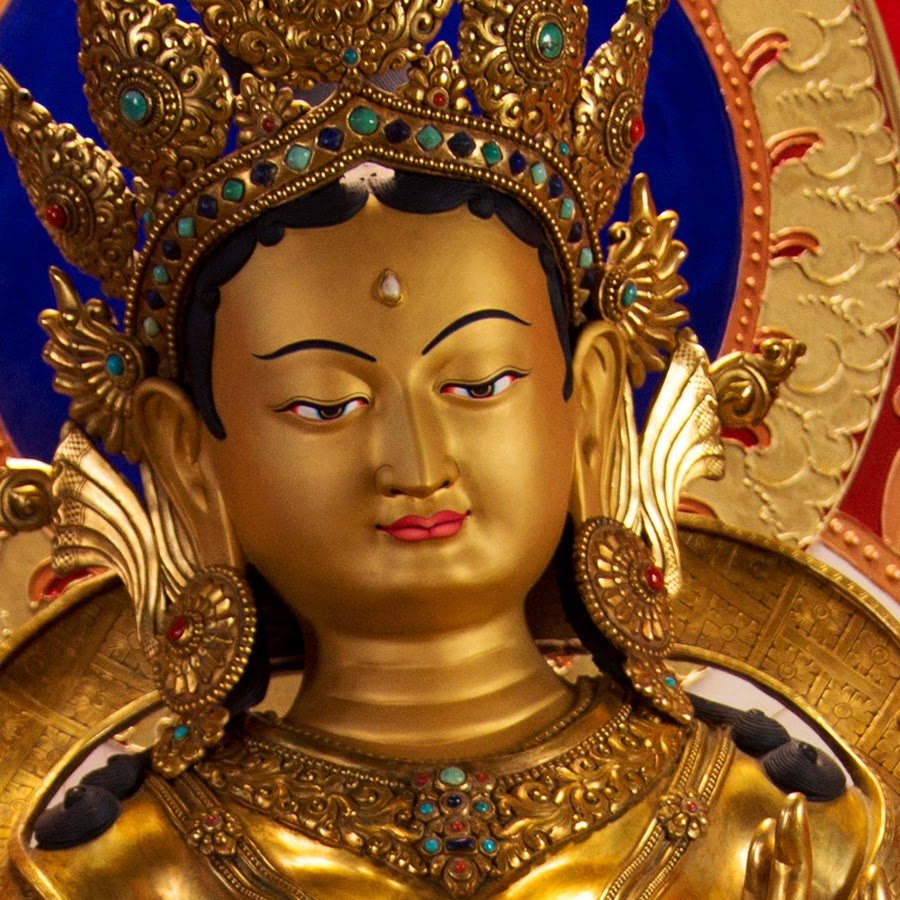
Tara- Mother of All Buddhas
Share
TARA
Tara, literally meaning "she who saves", her name means both "she who delivers" and "star"
An important figure in Buddhism, she has her origins in ancient India, where she is considered an emanation of the bodhisattva of compassion, Avalokiteshvara, thus symbolizing her feminine aspect and her unwavering compassion.
The earliest depictions of the goddess date from the 6th century CE, when Tara was considered the Shakti or wife of Avalokitesvara.
According to legend, Tara was born from a lotus floating in one of the Bodhisattva's tears in order to bring him help.
Tara has been one of the most popular deities in Tibetan Buddhism since the 11th century, mainly due to the influence of Atisha, an Indian Buddhist scholar and master. It was believed that the goddess manifested herself through every virtuous woman. Since then, she has been widely worshipped as an incarnate deity.
Tara is said to be the mother of all Buddhas because of her symbolic role as the manifestation of ultimate compassion and enlightenment. She is considered the source of all Buddhas and Buddhist teachings, representing the transcendent wisdom that guides beings to enlightenment. As the mother of all Buddhas, she embodies universal benevolence and infinite compassion towards all sentient beings.
Tara appears in 21 distinct forms, each with its own colors, postures and attributes, depicted sometimes in a state of serenity, sometimes in anger.
Among its most widespread forms are Green Tara and White Tara.
• Green Tara (Shyamatara)
Known as the Buddha of enlightened activity
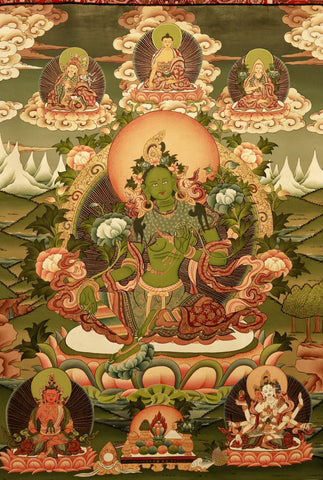
Green Tara, also known as Drölma Jang in Tibetan, represents the most widespread aspect of Tara.
Its green color symbolizes awakened activity and compassion.
His right hand gesture expresses giving, while that of his left hand represents refuge, skillfully uniting means and knowledge.
The three raised fingers evoke the Three Jewels: the Buddha, the Dharma and the Sangha.
Holding blue lotus stems, she embodies full compassion.
His posture, with one leg bent and the other ready to rise, symbolizes his commitment to rescuing beings, even after transcending samsara.
Tara alleviates difficulties and guides towards liberation from suffering.
Green Tara's mantra is: om tare tuttare ture soha
Tare symbolizes the liberation of beings by Mother Tara from the cycle of suffering. This suffering is echoed in human torments: birth, aging, illness, death, unsatisfied desires and aversion. By turning to Tara and practicing her teachings, especially through By reciting mantras and praising, one escapes from these afflictions.
The term " tuttare " dispels the eight fears, which include external dangers such as fire, water, air, earth, as well as threats such as thieves and animals. However, the worst dangers emanate from ignorance, attachment, anger, pride, jealousy, greed, doubt and wrong views. By freeing oneself from these disturbing thoughts, "tuttare" emancipates one from the real cause of suffering: karma and its tormenting thoughts.
The word " ture " frees you from illness. In the context of the Four Noble Truths, "ture" represents the end of suffering, the very essence of the Dharma. By freeing oneself from illness, one actually frees oneself from its true cause: ignorance of the fundamental nature of the self and the disturbing thoughts that arise from it. Thus, "ture" emancipates us from mental torment and true suffering.
The general meaning of these three words, " tare tuttare ture ", can be interpreted as follows: "I prostrate myself before you, incarnation of all the actions of the Buddhas, whether I am in happiness or in adversity, with my whole being: body, speech and mind.
The final word, " soha ," expresses the rooting of the path in your inner being. By sheltering under Tara and practicing her teachings, you receive her blessings deep into your heart.
This gives you the opportunity to cultivate this path within your being, symbolized by "tare tuttare ture". By following the teachings of the three enlightened beings, you purify your entire being, body, speech and mind, to access the vajra purity, the holiness of Tara's speech and mind, symbolized by "om". Thus, your entire being is transformed into a sacred sanctuary dedicated to Tara. This is the evocative meaning of "om tare tuttare ture soha"
• White Tara (Vajradhatvisvari)
Known for her infinite compassion, longevity, healing power and serenity, White Tara is also worshipped as the "Wish-Fulfilling Wheel", or Cintachakra.
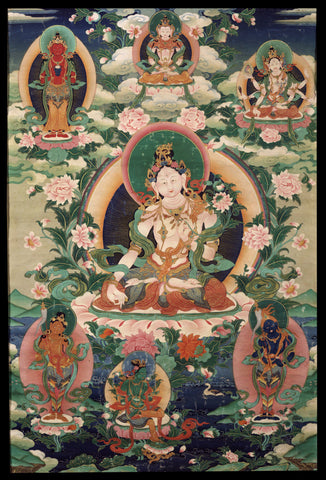
In Tibetan tradition, White Tara is sometimes seen as a variant of Green Tara, associated with Sarasvati, wife of Brahma. Known as Drölma Kar in Tibetan, she represents longevity. Her initiation and practice are invoked for long life and in cases of serious illness. Disciples often offer images of White Tara or other long-life deities to their spiritual masters, praying for their longevity and guidance.
Although all forms of Tara embody compassion through their connection to Chenrezig, it is White Tara who is most intimately associated with her core compassion.
Her pure compassion for our suffering, supposedly surpassing even the love of a mother for her child, is represented in Tara images by her white color. This whiteness also symbolizes the "undifferentiated truth of the Dharma
Compared to Green Tara, who is often depicted sitting with one leg on the ground, ready to intervene in our defense, White Tara adopts the more meditative posture of the diamond lotus, with both legs folded beneath her and her feet pointing skyward.
White Tara is endowed with seven eyes - one on her forehead, one on each hand and one on each foot - representing her compassionate vigilance to perceive all the suffering in the world.
Her left hand adopts the protective mudra while her right adopts the wish-fulfilling mudra. Typically, she holds in her left hand a stem of Utpala lotus with three flowers. One flower is a seed, the second is ready to bloom and the third is fully bloomed, symbolizing respectively the Buddhas of the past, the future and the present.
Frequently, a small representation of Amitabha, a Buddha renowned for his longevity, is depicted either in the crown of White Tara or slightly above her head.
Find our article on the Buddha Amitabha on our blog by clicking on this link
The mantra of White Tara is:
Om Tare Tuttare Ture Mama Ayuh Punya Jñana Pustim Kuru Svaha
The White Tara mantra begins in the same way as the fundamental Green Tara mantra, the explanation of which is provided earlier in this article.
Mama Ayuh Punya Jñana Pustim Kuru Svaha
mama = mine, means that I would like to possess the following qualities
ayur = long life
punya = merit that comes from living an ethical life.
jnana = wisdom
pushtim = increase
kuru = do it! Do it now!
svaha = may the blessings be upon
The Origin of Green Tara and White Tara: The two Chinese and Nepalese princesses, wives of the Tibetan king Songtsen Gampo:
The Chinese princess Wencheng, sent by the Tang Dynasty, and the Nepalese princess Bhrikuti Devi, who married the Tibetan king Songtsen Gampo, are both considered incarnations of Tara. Wencheng is traditionally associated with White Tara and Bhrikuti Devi with Green Tara.
The story goes that these two princesses played a crucial role in introducing Buddhism to Tibet. They brought with them statues, sacred texts and Buddhist teachings from their homelands.
Legend has it that these princesses urged King Songtsen Gampo to build the first Buddhist temple in Tibet, the Jokhang, in Lhasa, where they placed the statues of Green Tara and White Tara. These two deities then became central figures of Tibetan Buddhism, embodying compassion and wisdom.
Thus, according to tradition, Green Tara and White Tara have been worshipped in Tibet for centuries, with legendary tales surrounding their origin linked to the two royal wives who came from elsewhere.
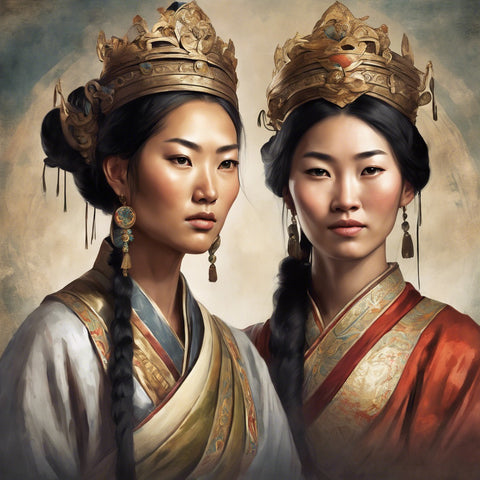
• Red Tara (Kurukulla)
Sporting a fierce appearance, she is associated with the attraction of all blessings.
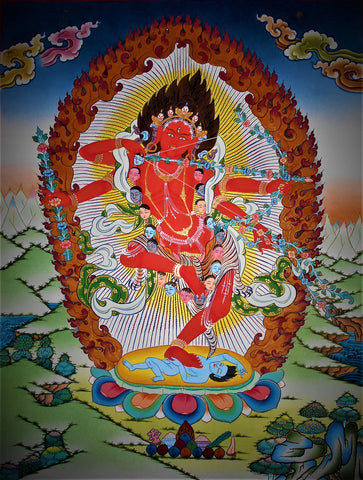
Red Tara, also known as Kurukulla, is worshipped by desperate lovers, being renowned for her power of enchantment over both men and women. It is said that reciting her mantra ten thousand times fulfills all wishes.
Sometimes, sporting a fierce aspect, she descends to earth to come to the aid of humanity by removing the most difficult obstacles.
It holds the power to radically transform a life in an instant.
Red Tara is a deity often honored by unsatisfied lovers, as she is said to excel in the art of charming beings. She embodies the Buddhist goddess of witchcraft and enchantment.
It can be called upon for control practices aimed at attracting, manifesting, magnetizing and subjugating.
Red Tara embodies extraordinary sensuality and seduction. Her bewitching power lies in carnal desire and love, enveloping people in her grip.
When difficulties hinder your connection with your partner, the goddess Red Tara can be invoked to help you whisper tender words, stimulate your sensuality, explore your eroticism, deepen your intimacy, reveal and fulfill your lover's fantasies, and imbue love with fire and romance.
Red Tara Pose:
Standing precariously on her raised right leg, she supports her impressive frame on her left leg, under which she tramples Kamadeva, the god of desire.
She has four arms and holds various symbolic attributes. Two of her main arms hold an arrow, stretched on a flowered bow. The shaft of this arrow is made of flowers and the flight is made of leaves.
His upper right hand holds a flower hook and his last left hand holds a noose. These two tools allow him to catch those who have strayed from the path of Dharma.
She is extremely seductive: her red color and captivating floral attributes underline her seductive power, bewitching men, women, ministers and kings with sexual desire and love.
To capture or subjugate a man, the hook-flower and arrow are visualized as piercing his heart; and to attract a woman, these attributes are imagined as penetrating her vagina.
From the eight-petalled red lotus in the center of the practitioner, eight red bees emerge, which seem to fly out of his nostril to enter that of the person to be subjugated.
There they suck the vowel syllables out of that person's heart with their "pollen collecting suction tubes" and then return with their "nectar" to the practitioners' hearts.
The symbolism of the red bees intoxicated with honey, the red utpala flowers laden with fragrant nectar, and the catching, clinging and piercing activities of Kurukulla's floral attributes, reveal the sexual magnetism of this seductive goddess.
The mantra of Red Tara is: Om Tare Tam Soha
TARE symbolizes liberation from earthly suffering, the end of the torments of samsara (infinite cycle of rebirths).
TAM represents the initial syllable of the goddess Tara, located in the heart chakra, a sound source as bright as a ruby, radiating throughout the world.
SOHA translates to “may my mind receive, absorb and retain the blessings of the mantra, and may they take root within me.”
• Black Tara (Ekajati.) , associated with power
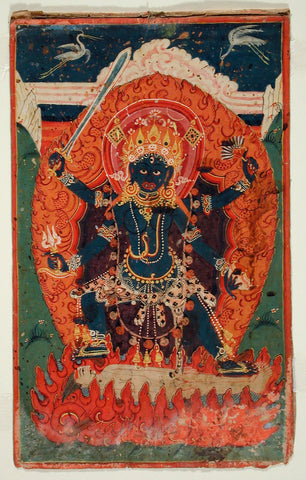
Black Tara embodies the enlightened activity of anger, characterized by the use of energetic methods to carry out beneficial actions that cannot be achieved otherwise.
She appears in a wrathful form, sharing a similar appearance to Kali in Hinduism, and is associated with power.
Like Kali, the Hindu goddess associated with destruction, transformation and renewal, she wears a crown decorated with smiling skulls and has three eyes .
Like many angry-faced Tibetan deities, she bears the fangs of a tiger, symbols of her ferocity and insatiable appetite for vanquishing the demons of the mind. Her blazing aura, imbued with energy and smoke, embodies the transformative power of fire.
Black Tara is sometimes associated with the ultimate protector of the void, the Divine Mother of compassion, and a powerful Goddess capable of warding off all forms of evil.
The black tara mantra is:
Om Tare Tuttare Ture Sarva Vidya Avarana Ye Bhye Phat Soha!
Oh Tare Alla Soha just like the mantra of Green Tara mentioned above
This mantra is recited for Tara to remove mental obstacles that hinder understanding or emotional forces that obscure mental clarity.
Avarana refers to the root causes of negative tendencies in ourselves or others.
These instincts, impressions, or powers are deeply rooted, influencing behavior beyond conscious awareness. They remain unconscious, unexamined, and untransformed. They are often denied, repressed, or avoided. You or others may have difficulty consciously recognizing them, or perhaps you prefer not to.
Like many words in Sanskrit, " vidya " has multiple meanings depending on the context. Often translated as "wisdom," in this context it refers to "intentions," especially negative intentions.
“ Bhye phat ” encourages Tara to overcome and destroy these obstacles or difficulties.
The mantra implores Black Tara to overcome the negative intentions of the adversary.
• Yellow Tara (Sita Tara) , associated with wealth and prosperity
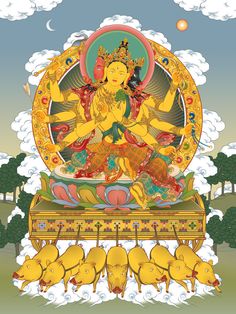
Sita Tara promotes the realization of your goals. You implore (kuru) Tara to encourage (pushtam) your vital energies (ayur) and merit (punye), thus helping to spread positive energy to all creatures on the planet, near and far, when you recite the mantra of Yellow Tara.
The mantra of Yellow Tara is:
OM TARE TUTTARE TURE SARVA AYUR PUNYE PUSHTAM KURU SOHA
" Sarva " is a Sanskrit term meaning "whole" or "all." It is often used to indicate universality, the inclusiveness of all that is concerned or involved. In the context of the mantra, "sarva" can be interpreted to refer to the whole of life, all things, or all forms of well-being and prosperity.
" Ayur " refers to life, vitality or longevity. In the context of the mantra, it is interpreted as an invocation of health, vitality and longevity for oneself and others.
" Punye " refers to the merit, virtue or good deeds accumulated by a person. In the context of the mantra, it is interpreted as an invocation of the accumulation of positive merit for oneself and others.
" Pushtam " means "favorable" or "to stimulate." Used to encourage growth or strengthening of vital energies and merit.
By reciting the Yellow Tara mantra, you implore (kuru) Tara to amplify (pushtam) your vital energies (ayur) and merit (punye), thereby helping to spread positive energy throughout the world, for the well-being of all, near and far.
• Blue Tara, (Nilatara) associated with the transmutation of anger
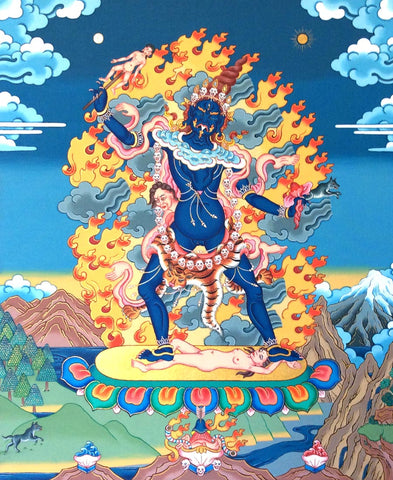
Nilatara, is a powerful and fearsome deity in Tibetan Buddhism.
Her hair is messy and wild, while she wears a crown of human heads and bone ornaments. Around her waist, she sports a belt made of tiger skin, in addition to a crown of skulls and bone ornaments.
In her peaceful form, Nilatara is said to grant wishes, long life and good health. However, in her wrathful form, she is invoked to protect against harmful influences and remove obstacles on the path to enlightenment.
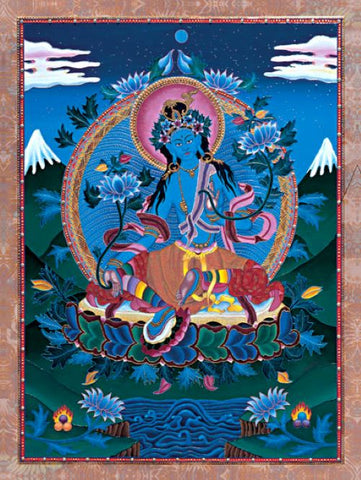
Nilatara is particularly associated with the tantra known as "The Deep Inner Meaning" or "The Secret Core," which is believed to reveal the innermost secrets of the mandala of peaceful and wrathful deities.
Nilatara is also the mother of the Dakinis, who are female spirits or celestial dancers, representing the feminine aspect of enlightenment and acting as messengers of the gods. In Tibetan Buddhism, Ekajati is considered one of the eight main Dakinis, powerful female figures believed to act as guides and protectors on the path to enlightenment.
Each of the eight dakinis is associated with a different aspect of the teachings, and Nilatara is associated with the practice of tantra. Blue Tara is often depicted in thangka paintings and statues, and is an important figure in tantric rituals and practices. She is also invoked in prayers and mantras, and her image is used as a focal point for meditation.
Tara in her blue form is a powerful and revered goddess in Tibetan Buddhism, believed to protect practitioners from negative influences and help them overcome obstacles on the path to enlightenment.
The mantra of Blue Tara is: OM BHIM TARE VRIM
" Bhim " is a sacred syllable, or seed syllable used to invoke the energy and presence of Blue Tara, in meditative and spiritual practice. In this context, "Bhim" acts as a sound vibration that stimulates awareness and spiritual connection with Blue Tara.
The syllable " Vrim " is meant to dispel negative and obstructive energies, while "Vrim" is said to pierce them.
Just as Blue Tara is credited with this ability, these two syllables along with the syllable " Tare " will protect you from obstacles and your adversaries.
It is said that reciting or listening to his mantra completely removes obstacles in your life.
Tara emerges as a central and versatile figure in Tibetan Buddhism, embodying the feminine aspect of compassion and enlightenment. Through her various forms, she offers practitioners a multitude of avenues to engage in their spiritual practice, whether to overcome obstacles, obtain protection, healing, prosperity, or develop wisdom.
The cult of Tara, widespread for centuries, continues to inspire and guide followers on their path to enlightenment. Her mantras, symbolic postures, and iconographic attributes are not only ritual elements, but powerful tools for cultivating qualities such as compassion, clarity of mind, and inner strength.
Whether in the calming form of Green Tara, the protective White Tara, the magnetic Red Tara, the powerful Black Tara, the prosperous Yellow Tara or the transformative Blue Tara, each manifestation of Tara offers assistance and support to sentient beings on their spiritual journey.
By honoring Tara and engaging in her practice, devotees discover an infinite source of compassion and wisdom, guiding them toward realizing their full potential and the well-being of all beings.
May devotion to Tara continue to light the path for those who seek refuge and inspiration in the Buddha's teachings, guiding each to the blossoming of their heart and mind.
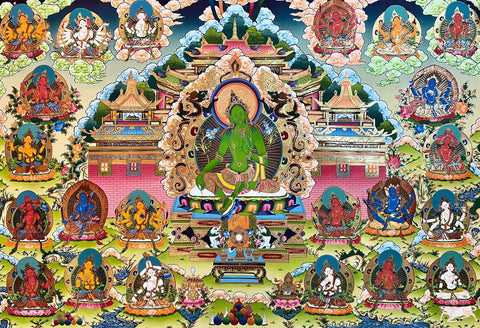
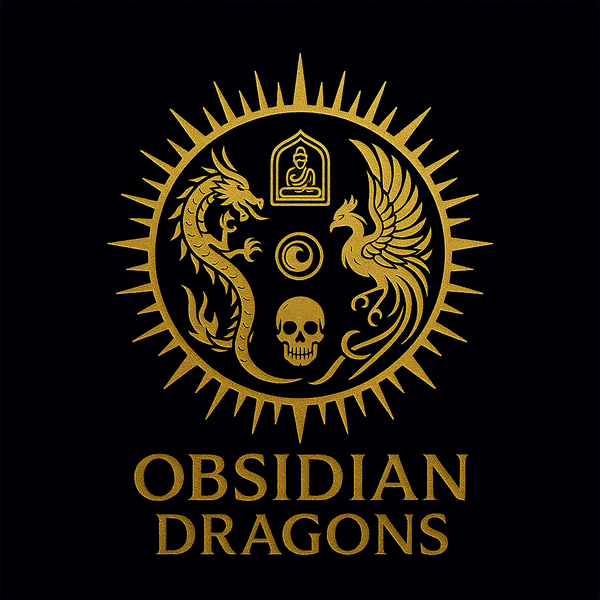
1 comment
Merci c’est très chouette !! Namasté